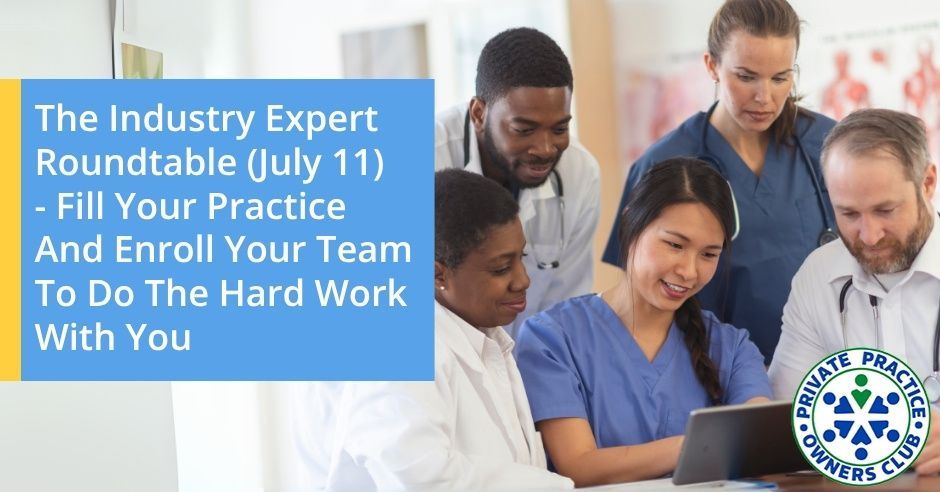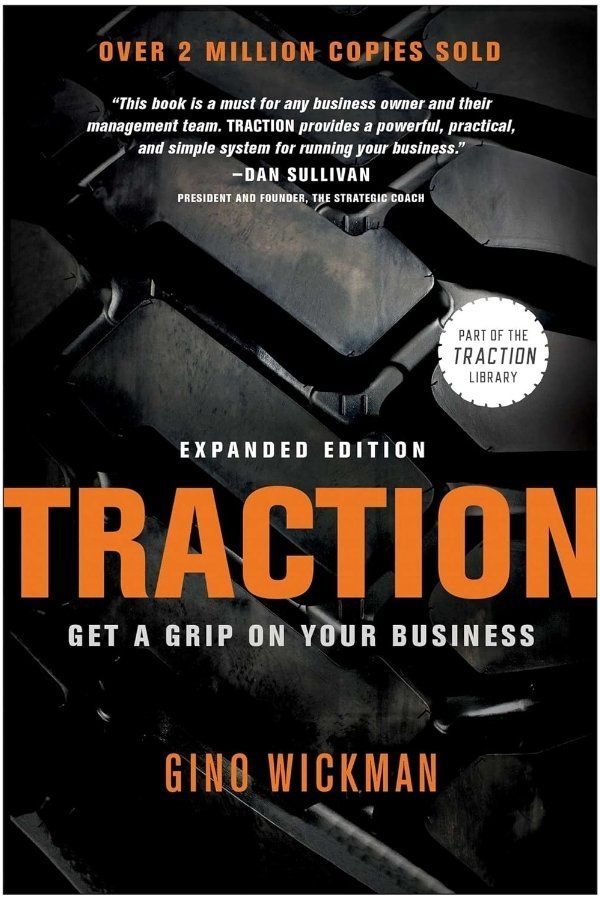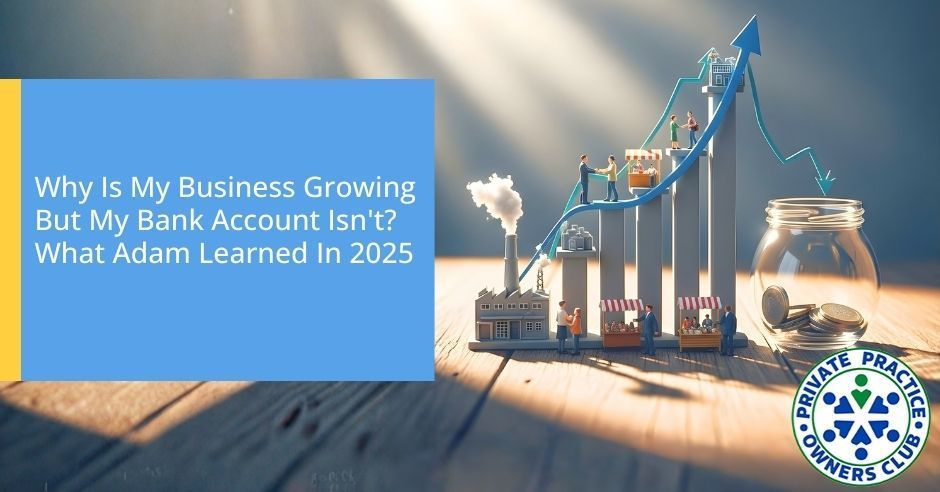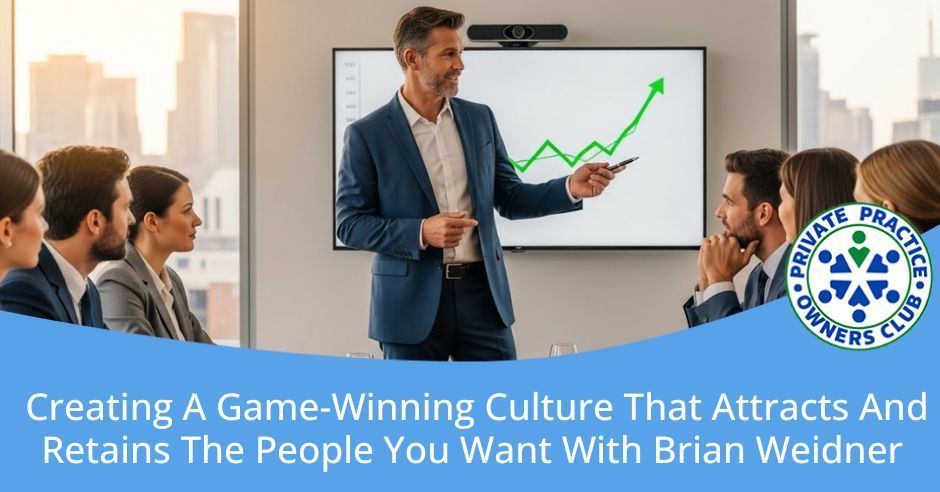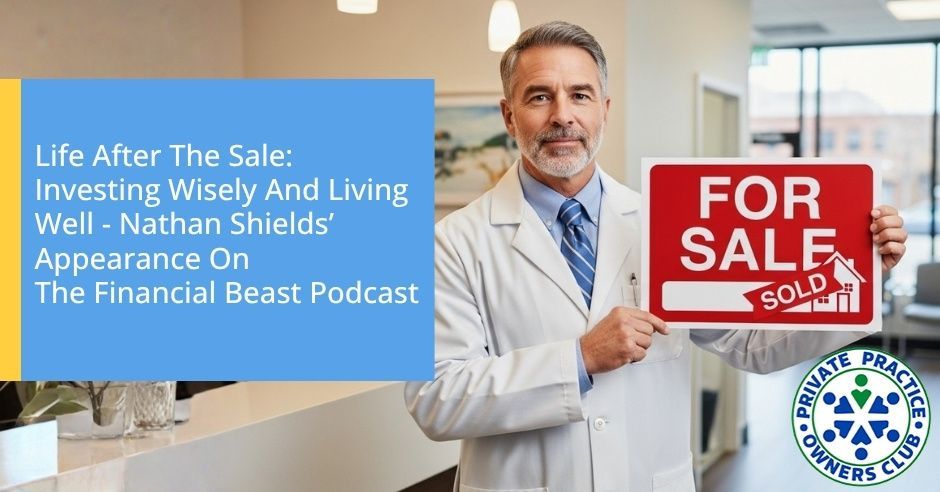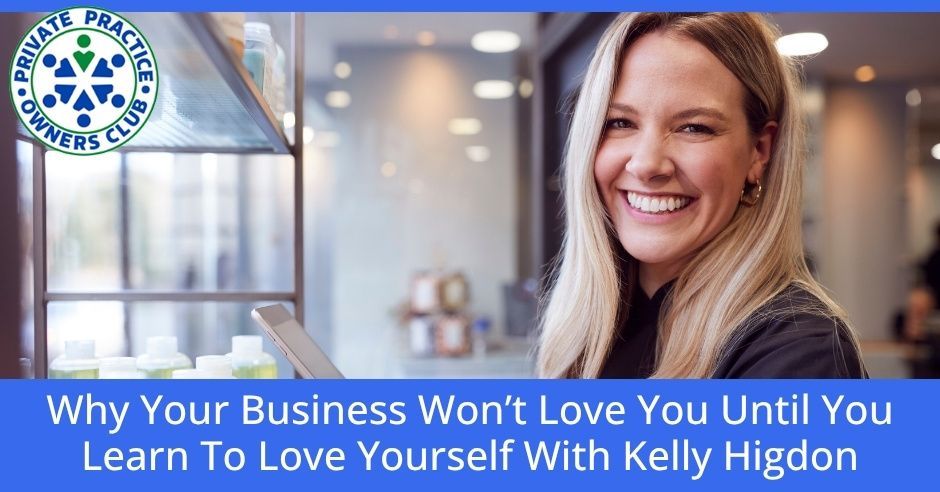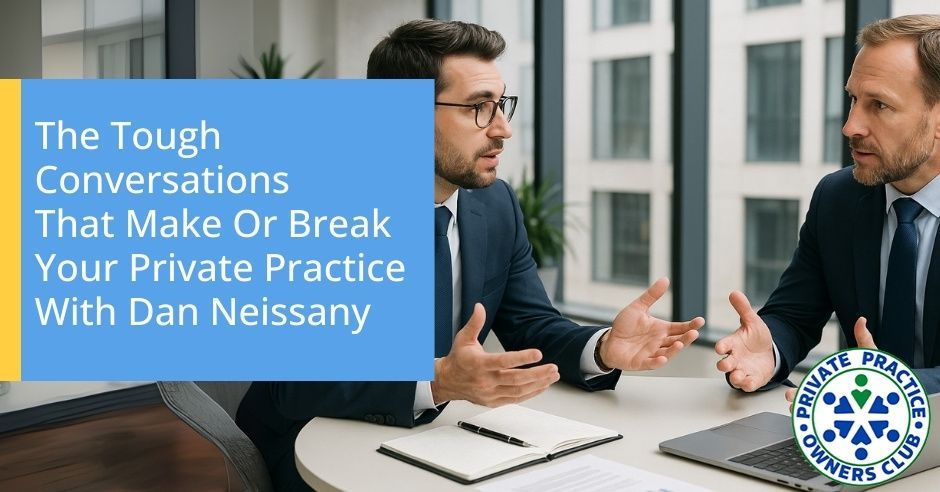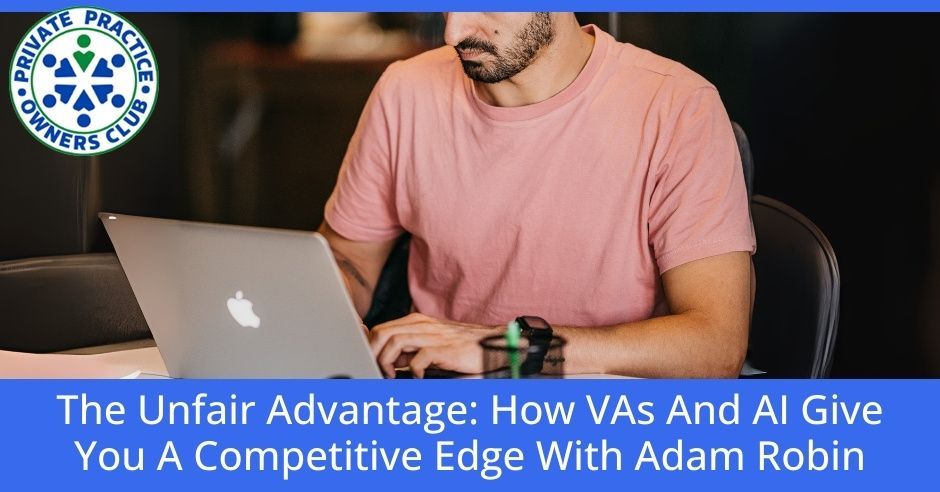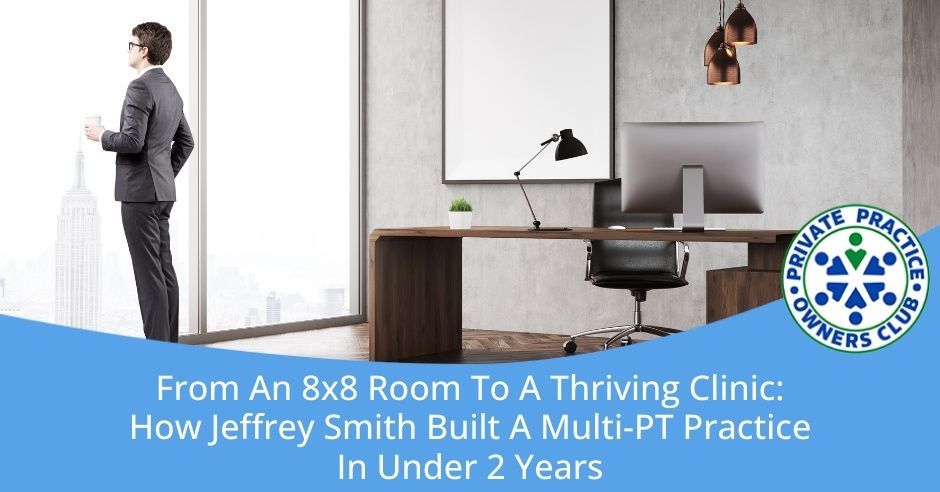In this high-impact roundtable, Nathan Shields brings together three leading voices in the private practice space to tackle two of the biggest challenges clinic owners face today: filling your schedule with new patients and enrolling your team to take ownership in driving your business forward. Join expert panelists Adam Robin (co-owner of Private Practice Owners Club Coaching), Justin Gilligan, (founder of Carbon PT Marketing), and Greg Todd (creator of Smart Success Healthcare) share actionable insights, hard-won lessons, and proven strategies to help you stop doing it all yourself and start building a practice that runs with clarity, consistency, and collaboration. Whether you are a seasoned owner or scaling your first location, this episode is packed with the kind of wisdom that turns stress into systems and effort into results.
---
Listen to the Podcast here
The Industry Expert Roundtable (July 11) - Fill Your Practice And Enroll Your Team To Do The Hard Work With You
Discussion With Justin Gilligan, Greg Todd, And Adam Robin, Hosted By Nathan Shields
In this episode, we're talking about filling your schedules and get our teams to be productive, something that all owners have to work at, I'm assuming. Otherwise, you wouldn't be on here. Even if you are a little bit further along in your ownership journey, you're going to be talking about how do we get more patients. How do we fill our schedules, and how do we get these teams to be productive? I’m excited to have you guys on the show. Welcome to our guests. Also, Justin Gilligan of Carbon PT Marketing, and TheraFit Rehab. Good to have you on, Justin. It's nice to meet you. I don't think I’ve met you before, but it's good to have you on.
It's good to meet you too, Nathan.
Greg Todd
of Smart Success Healthcare. Greg, I think I had you on the show years ago. Impressive at the time. I’ve tracked you on social media ever since. You're doing great things. Good to have you on as well.
Thank you, Nathan. I appreciate you.
I did fail to recognize my partner, Adam Robin. I took it for granted that you were there.
Yeah. I'm going to give a little hype to Justin and Greg. I met Justin randomly. We just connected on social media and when I got on a call with this dude, I instantly realized this guy knows what he's talking about. He's really sharp, knows a ton about marketing. Nathan, do you think you're good at metrics? Wait until you hear this guy talk. He's dialed in across the board. He's got multiple companies. I felt like it was really cool to have Justin on.
Greg. If you guys don't know Greg, you guys have been living under a rock. This. We did a podcast. He's the OG of private practice success. I remember being in PT school watching this guy on the internet thinking like, “I want to be like him one day.” I mean that really seriously. He's done a lot for the profession. He's somebody that I really admire. I think he's got a lot of cool things to add, too.
Thanks for shouting him out. I really appreciate it because I haven't had a lot of interaction with either of them outside of Greg in my episode a number of years ago. I'm excited to get to know you guys, but I know there's a lot to offer here. One other thing I will share here as we're going through the process, Adam, Justin and Greg have all shared some free resources to give to all those people who have come to this episode. I’ll let Justin, Greg and Adam all talk about those a little bit.
I also have to say, if you haven't noticed already, we have our conference coming up in October 2 through 4 in Destin, Florida. This is going to be an awesome event. It'll be our second annual event, but we've got some great speakers coming up. These are people who either own 10, 20, 40 clinics and know how to scale. Even if your mindset is like, “If I want to get to twenty clinics,” these guys have the secrets that, even if you take those things and put them into your singular practice, will make a huge difference. They started where you are. They know how to get to these huge companies and they have a lot of secrets to share. We've got a number of those people speaking as well like Scott Gardner.
I'm excited to have Scott Gardner coming, talking about the state of the industry right now and what he sees is severely impacting the private practice space. I'm excited to bring him on as well. Make sure you register. There is an early bird discount going on right now, and that will keep going for a couple of 3more weeks, but don't wait too long. We've got specials on hotel rooms as well. Check out the link. It has all the details, the agenda, etc., that you might want to know. We got votes both ways as far as where to where to start the discussion. I will start with this. Is there anything else you want to add, Adam, before we start getting into the topics at hand?
No. I don't know about Justin and Greg, but I do really like bouncing off of specific questions. If there's something super specific, the more targeted we can get the topic, I think the more value we can bring, but if we stay like productivity, what does that mean? Is it the hard conversation? Is it the metrics part? Is it the onboarding process part? There's a lot of things we can talk about productivity. The more specific we can get around the questions, I think the better value that you guys will get out of it.
How To Determine Your Team’s Productiveness
Let's first talk about team production. When we're talking about productivity, it's a common battle no matter what industry you're in when we're talking about getting the teams to be productive. I'd like to know from you, and maybe we'll start with Adam on this one, and then we'll go from there because I know Adam's got some ideas on this one in particular. We just had our conference in national talking about this. When you're a leader? How do you know if your team is productive or not?
How do I know?
Yeah.
I like to make this a math problem. I think the more objective we can be about this, the better. I think that's a good place to start. I don't know if that solves a lot of problems, but a lot of things changed for me whenever I decided that the finance department was going to be the department that establish the productivity standards. At the end of the day, the business is just a big math problem. It's money coming in, money going out. You have to take that money and allocate it in the most efficient way possible so that, hopefully, there's a little bit left over at the end of the week or the end of the month.
However, if we remain emotional about that question, then you're going to be limited by the emotions that you're feeling. The problem about emotions is your business doesn't understand emotions. They don't care if you're having a good day. They don't care if you're having a bad day. The only thing that it cares about is, does the math, math. I think the data is really key to getting objective around where your productivity standards need to be in the business.
Is it not uncommon as you're coaching people that they're not totally clear on whether their team is productive at all? I guess what I'm looking back on myself as a young owner thinking I based my team's production on my bank account, frankly. If my bank account was looking good, then we were being productive. I think you're actually saying that, but there's more to it than that. We need to know a little bit more. It is a financial situation, but it is a little bit more than that.
Of course. I think that there's three primary players here. There's the business or the bank account. That's one pillar of this question. There are the patients because there is a line. If you get too productive and you start turning into the mill, the M word in the industry, like, you're not really able to connect with your patients the way that you really want, so there's an important factor there, and then there's the team. If we push too hard, then you can lead to burnout. If you're under productive, then they can be unfulfilled as well.
I remember adopting this mindset and a lot of things changed for me whenever I decided that my bank account and the financial health of the business was just as important as the patients and as the providers. Not more important, not less important, but evenly important. Whenever I established that agreement with myself, and I decided like, “This is important. This is just as important,” and I started enrolling my team into that agreement like, “It's okay to have conversations about money. It's okay to make sure that we're financially solvable. That's okay.” That framework really helped unlock a lot of the hard conversations that I had to have around productivity.
Your business does not understand emotions. Data is key to setting objective productivity standards.
To me, there's that mix of like, if I can measure this, then I know we're on track. I think that's probably what Adam was alluding to. We have scorecards and the scorecards have these numbers on them. It's like how satisfied are our therapists? How satisfied are our customers? What does the bottom line look like every month? How satisfied are we with that?
How Your Team Can Achieve Your Set Goals
When we're talking about the standards that Greg is talking about, and you brought up management, which you're talking about now with KPIs and whatnot, let’s say we've set the standards. We know what our profit margin is and we've asked the question, how do we meet this? If we're going to really meet the standard, what are the KPIs we need to hit? What is the MPS score we need to hit in order to fulfill our purpose as an organization?
Now, we've done some reverse math, if you will, on maybe the units that we need to hit, the number of patients that we need to hit on a regular basis, the number of visits and new patients. We have to have the right mix of CPT codes. There are things that we can learn and we need to get this percentage of over-the-counter collections on a regular basis and this low-level denial rate in our collections. There's all these metrics that we can hit, the KPIs that we can have, which are standards, like Greg said. How do we then manage to make sure our teams reach those or achieve those goals? Where are some of the first places you look? We'll start with Justin. We'll go to Greg after that.
You had Arlan Alburo on this show before. I love Arlan. He's a good friend of mine, such a great guy. Mentor in a way. Awesome guy. One of the things that he talked about on this show, I think, it was the thirteen steps to persuasion. He gave me that framework a couple of years ago, and I implement that religiously. If the KPIs are off, now it's about three things, going back to Traction. It's either the training, you didn't train them the right way, you don't have the right process and procedure in place, or you have the wrong person on the boat. It's going to be one of those three things. We got to dig into it.
Is the process not working? Are they not following the process, or is it just the wrong person? When you dwindle it down to just those three things, it becomes far more biteable and easier to start consuming. Once you figure out what it is, let's say it's the process, then on our leadership meeting, we're going over the process. Someone's assigned to it. They're rewriting the process.
That's the fun thing about business management. You don't have to do it the way that everybody else does it. You can fail, and you can come back to it and rewrite it. That's the fun part about owning a business. You get to do it your own way. You're the person in charge, and you get to put the right people in the right seats and have an awesome team to help you with this. Often, it's overwhelming to practice owners. I know it was for me at first when I was doing all this for myself. You need a good team to help you hold these things accountable.
You brought up the three things that reminded me of, very similarly, Alex Hormozi said the same three things. If someone's not being productive or doing the things that you want them to do, it's because of 1 of the 3 things. Either they don't know what the expectation is, they don't know what the standard is, in Greg's vernacular. Number two, they don't know how. They don't know the processes. They don't know what formula they need to follow in order to achieve that. Number three, they don't want to, or they haven't bought in, or they don't know how it's going to affect them.
How does this benefit me to meet those standards? They haven't made those brain cells connect. I love how you brought up those very three very simple things. As a small business owner, a lot of it is, even with a coach, we can give you ideas, but when you're in the heat of battle and trying to hold someone accountable, and a lot of times, at the very beginning of your ownership journey, you don't have the words to say. You’ve got to trial and error this thing, and make this work. What are you thinking about this, Greg?
I think the first thing, at least with your team members is, here, let's talk about this first. Reframing productivity. I want to give you guys two quick stories. We're actually moving residence right now, but my son has been working at a local supermarket called Publix. That's what we have here in Florida. When my son comes home from work, I’m like, “How was your day?” His best days are the days that they're busy. He says, “The days that stink are the days where it just feels like it's dragging on and on. No customers are coming in. There are no shipments, there's no this and that.” That's the first thing.
My wife and I, when we went from our Orlando property back to here, back to the beach, we went to one of our favorite spots. It's super hot here in Florida right now. It's like 94 degrees. There was nobody at this restaurant. It’s our little favorite hole in a wall place called Bait House and Tavern at Marina. As I was looking at the waiters and the waitresses, they were just standing around and there was nothing to do. We know them well because we go there quite often. They're just like, “Yes. We're counting down the clock. We're so happy you guys came in.”
My point is that as therapists, we have been trained, indoctrinated from school that the least amount of patients we see the better it is. That's actually not human nature. Now, I'm not saying the M word, the mill thing. I'm not saying that, but at the end of the day, I think everybody, as humans, deep down, we want to be able to serve people at the highest level we possibly can serve them at or serve as many people as we possibly can.
The one thing I make sure I do across the board, it's just to reframe this whole productivity thing from the minute you come into my company. If you want your career to take off, a lot of people want to work with me, because, like what Adam said earlier, “I want to be like that guy.” If you want to be like that guy, here's what I can tell you. You've got to have a mindset of I want to either, A, help as many people as I possibly can, or B, with the skills that I have, I want to help them with the biggest problems that they have because that's how you get there.
Let's reframe the productivity thing first with people. I think once you do that, now, let's start to put people in the right seats. Justin alluded to it. What do those seats actually look like? I think in most clinics, you have two groups of people. There's actually three. There's us, which are the entrepreneurs, but everybody else isn't. Everybody else is not the entrepreneurs.
The entrepreneur is the person who owns, operates the business, and is willing to do so at a very high financial risk. The rest of the people that work for you do not want to do that. That's why they're working for you. I do think that there's two different types of seats. I think there's intrapreneurs and I think there's employees. The intrapreneurs are the people that take ownership. They operate the business. They just don't want to do so at a high financial risk.
What I have realized is that whether it's the clinics or the consulting business, the software business, I have a lot of intrapreneurs and I set up their productivity a little bit differently than what I do with the employees. The employees are people that operate a portion of the business. They don't take massive ownership. They're not going to take the work home with them. They're not going to do that. I think if you understand there's a difference between the two, intrapreneurs are the ones that are willing to be like, maybe you're not going to see as many people productivity-wise, but you are going to start a new initiative that we have at the clinic. Intrapreneurs love that stuff.
My productivity for my intrapreneurs is different than my productivity for employees, because employees just want to do one thing. They want to do one main thing, and then they want to get out of there. I just feel like, yeah, we have to reframe productivity, yes, but we also have to know who are we dealing with here. If I tell Barbara, “I want to start some new online thing,” and Barbara's more of an employee type, “I just wants to treat patients,” that makes Barbara nauseous. If I tell Tim over here that, he's like, “Yeah, and you know what I’ll do? If this thing takes off and we are able to execute on this, if you want to be the head of this, I'm willing to give you 20% of whatever we get for profits, for revenue, etc., etc.”
I just feel like productivity needs to look different depending on who it is that we are talking to. Somebody that's straight therapy, just make it simple for them. You want them to do evals, you want them to do treats, whatever that is based on your standards, set that up for them. Have your numbers right, yes, that's important.
Also, know who is who. There are some people that if they do that for the next 2, 3 years, even if you've hit every number but they're entrepreneurs, they're leaving regardless. They're leaving because they're like, “I’ve hit my max here. I can't level up anymore.” Understand the difference between the two, treat them differently and treat them in a way based off of your standards that you have and set up productivity for you and them to win.
Yeah, definitely. What are you thinking about that, Adam?
Make sure you are recruiting as strongly as you treat your marketing.
I wrote down a whole policy through all this. I got notes. I love how Justin brought up the process, like you and Nathan spoke about, the knowhow and the desire, the why. I'm going to run through the, what I wrote down. Greg Todd talked about standards. I believe that in order to set a standard, you must ask for the standard. In order to ask for the standard, you must decide that you deserve the standard. You must have some self-worth. I think it all starts with self-worth, like deciding what we do is valuable. What we do is worth it. I deserve to be profitable. You deserve to be productive. We have to build that.
There's some self-worth thing there that needs to be built up. You then can set the standard and you can ask for it and communicate it boldly. You could say, “Team, we're going to do it like this because we're the best in the world and we're going to be the best in the world. This is what it looks like to be the best in the world in this clinic.”
Once you have that, you have your metrics, you can operationalize it. Productivity is not that complicated. It's like we have to see so many visits a week in order to make a margin. We’ve got to make sure we're collecting over the counter. We’ve got to make sure we're collecting on the backend with the billing and collections team. Make that the math problem.
Here's the key. Measure the stats and review them every week and decide when things do dip, because they will, I’ve never seen a practice owner that didn't have a dip in their production at some point, investigate it. “Justin, physical therapist over in clinic number two, he was a little low two weeks in a row. I probably should go have a conversation with him.”
I pull up to Justin's house and I'm like, “Justin, real quick. I saw your numbers were low. Can you walk me through that? Help me understand what happened from your perspective.” What I'm trying to do there is uncover, is this a process issue, is this does Justin know how to do it issue or is this a desire issue? This is the kicker, guys. Once I uncover that, you have to have the tools and skills as of a CEO to be able to solve those problems.
If it's a process problem, solve the process problem. As Justin mentioned, put it on the leadership team meeting agenda. Go to the meeting on Tuesday, talk to the director of operations, whatever it is. Have that process of debriefing the issue and fixing it. If it's a know-how issue, build the training. Build the training and the tools that your team needs so that they do know how. If it's a desire issue, have the frameworks that you like, like Greg just mentioned. What'd you call it? Reframe productivity. What are your reframes?
My reframe is like the win-win-win, the money, the business. That's my reframe. That's how we frame it up in our practice. What's Greg's reframe? How do you sell the production to your team? The real question is, so we all know what to do. We all know how to get our clinics productive. The real question is, why doesn't it happen? It's usually because the owner is treating 40 hours a week and they're not doing any of this stuff or they're avoiding the conversation, or they don't have a process in place, or they don't know how to train their team. I think that's the real reason why we're having a hard time with production.
Is that what you would think, Justin? Would you say that's about the same thing that's keeping owners from demanding and expecting production?
I think it comes down to I just tend to look at everything numbers. For instance, we track exactly how many plan of cares that we have across all six clinics. I could pull up a sheet and it'll show me exactly how many plan of cares we should be scheduling for next week. It's a patient arrival tracker. It's like, I know we should have, let's say, 100 visits scheduled for next week. Is that number good or bad? How many spots do I do my therapist have? How many spots can they treat? That becomes the next number. If that number is under, then we have a marketing problem. I need to get more patients in to fill my therapist up.
If it's that we're not scheduling those patients out, then we have a scheduling problem. My front desk needs to do better at scheduling. If they're not arriving, then we have an arrival problem. I need to work on the arrival rate. For me, it's just a math problem. It's like I either have a marketing problem, I have a scheduling problem, I have an arrival problem, maybe I have a drop off problem, maybe my length of stay isn't long enough.
It all comes down to the numbers. If I can look at one place and I can see all the numbers, and I can dissect this, “Utilization is consistently at 76%. Why? It's because I don't have enough patients. What are we doing to increase the amount of patients that we're having into the practice?” Are we doing past patient reactivation? Are we going to doctor's office and asking for referrals? Are we doing Facebook, Google ads? Whatever.
If it's the arrival rate, then it's like, what the heck is happening? Why aren't patients valuing our services enough to show up to the appointments. How can we create more value? How can we get them to show up? Maybe we need to do something right before the patient leaves the visit and we need to reaffirm their next visit or make sure they're at their own schedule or tell them what we're going to be doing at the next visit. The numbers are going to tell me what I need to do.
Just really quick on that, even if you have the numbers, for me, and I'm a numbers guy as well, so this isn't necessarily difficult for some owners, but for people like me, how then do you have the number and you know the idea, or you have an idea of what it could be, and then what does that conversation look like with the person?
Yeah. Let's give an example. Let's say schedule efficiency is what we call this number. Schedule efficiency is the number of plan of cares that should be scheduled next week as opposed to the number that are, and our goal is 95%. I should have 95% of the schedule filled out by Friday. For next week, 95% of my plan of cares are booked and scheduled. I want to average 95%. We're at 94% as a company on average.
We're doing pretty good in this metric, but let's say one clinic is at 91% next week. Now there's someone's hat. It's not my hat because I'm not in charge of the front desk. Someone's hat is, it's our director of admin. She's going to see that number, 91%, and she's going to go look at the process for that, which is, they should have everybody on that sheet say, are they scheduled and why aren't they?
She goes on there, she looks at it and she sees that everybody's marked on there. There are legit reasons. Let's say everybody's sick. There's not really anything we could do about people being sick. That process is being followed correctly. Let's say everything's empty, there's nothing going it, there's no accountability. The front desk isn't filling out the thing, they're not doing the process. It then becomes about the training because the process is there. They're not doing the thing.
How do I train them? If it's not working on a weekly basis, meaning this KPI, I'm measuring it every Friday and it's not happening, then it's going to be a daily KPI now, and it's like every day, I need you to go in and monitor this on a daily basis. My director of admin's tasked with making sure that happens. The front desk receptionist is making sure that every day, she's filling out the KPI report that it's getting tracked at 100%, my director of admins. It then becomes, how do I hold my director of admin accountable to that?
That goes back to the same thing. Training, process, person, do I have the right person in the right seat? Is she motivated? Is she an intrapreneur like Greg was talking about. Does she care about this type of thing? Is she invested? Can she hold other people accountable? We talk a lot about the five dysfunctions of a team in our company. Every single quarter, we go over them and over them.
I believe it's so crucial. You’ve got to have trust to have conflict, to have a commitment to something, to hold them accountable and to achieve results. There's this layer of complexity that goes down to management. If you can figure out that management complexity and how to manage someone, how to truly get them to have healthy debate and conflict and bring up the harsh things, all these complexities and management, then they'll commit to the thing. You can then hold them accountable to it. They’ve got to be able to buy into it. If you're just the person over there going, Fill out the sheet,” and they're not counteracting you, they're not debating you, you're not able to hold them accountable, then it's something deeper than that that you have to get into.
Greg, talk to me about this interaction that you have, and I'd like you to frame it in yourself as a younger business owner or how you coach business owners currently. How do you frame this conversation? How do you get them to buy in on something that's maybe on a standard, in your words, that is falling short?
Yeah. I'm going to tell you, but I know a lot of you that are reading right now, here's the truth. You know it's the truth. You're scared to piss your therapist off. You're saying like, “Wait, how do we have these conversations?” You have the conversation by having a conversation. The reality is that we're not having a conversation. Not because you don't know how to speak, you're not having a con conversation because you're scared to piss them off.
I'm going to give you the answer of how I had the conversation right there and what I say. I think that all of you know how to talk. You know how to have a conversation. You have conversations with your patients all day, but you're scared to piss off therapists. Here's the thing I need to say before I actually tell you the answer.
A lot of people have marketing issues, a lot of people have recruiting issues. Make sure you treat your recruiting as strongly as you treat your marketing. If you're not doing marketing and you're not doing recruiting, you're probably going to go out of business. You could be crushing the marketing, but if your recruiting's bad, then you start to run into problems like this.
You need to have a pipeline of people that want to work for you. You’ve got to have a pipeline of people where it's like, “That's the type of company I want to be a part of.” If you don't have that, then you and your therapists know that you're stuck with me. If I have these conversations and I piss them off, they might leave. If they leave, I'm going to have all these patients. We’ve got to get that part fixed. I'm not going to talk about that now. Now I'm going to answer the question of how do you have the conversation.
Hold on. I just have to say thank you for saying that because we've been preaching that from the choir. I'm worried that people that are in the meeting right now that are part of our private practice owners club are like, “Nathan and Adam say that all the time.” I'm just glad there's a third party, that’s verifying exactly what we're saying. I'm cheering you on. I'm like, “Please, more.”
Now everybody here hates me too. By the way, I don't know who taught me this. I’ve just been taught by so many people, but the way that I talk to my staff is by just giving them the compliment sandwich. The compliment sandwich is a good thing, a bad thing, and a good thing. Let's just say in this case, we're talking about productivity, and it's Nathan that we're having some productivity issue or whatever the case may be.
We're dealing with human beings here. At the end of the day, human being have emotions. Everybody wants to feel like they matter, that they're doing good work. I'm going to find something that I can say about Nathan to where I want Nathan to know how important he is to our company and to our mission. I start off with a compliment. “Nathan, I’ve heard so many patients say so many amazing things about you. Yes, we're a physical therapy business or we're an occupational therapist” or whatever. “We're also a people business. We're in the business of serving people and making people feel good about themselves. You've fit the bill. You really do. I got to just say I want to thank you for that. I love what you do for our company.”
Now, you know that. That's the first part of sandwich. Now we're going to go in the middle of sandwich. Now we're going to talk about the issue. “You know that that we're a company that needs to stay in business. Here's the thing. As an entrepreneur, I can tell you the first rule of business is sustain business. I have a responsibility to let you all know this is what we need to do for each of us in order for this company to stay in business. Right now, we're having an issue with your productivity,” or whatever the issue is. Now, guys, we’ve got to be direct. You got to be direct.
“This is a standard that we have here. Here's the numbers. This is the standard. This is where you're at right now. We can't continue to operate like this. Here's the reason why. If we are going to continue this, and we not only allow you to do this, but we allow Tina and this and that and everybody else, this company won't even be a company in 60 days. I have a responsibility to tell you that because I know that the type of person that you are. You want to be able to do your job to the highest sense.”
Now we're going to talk about how do we fix this? Now whether it's Justin giving them the their KPIs that they're filling out on a weekly basis, or we're in a remediation plan and we're making them do this on a daily basis, whatever the case is, now we're in the meat of the conversation and we're hitting those things. We’ve got to finish out with a sandwich. You’ve got to finish out with a compliment.
Sandwich is, “Nathan, I want you to know I believe you could do this. Are you on board with this? Let me tell you something. I believe in you. I believe in what you stand for. I believe in what you do for a company. I love the way that you treat our patients. I'm only having this conversation with you because I want to build with you.” That's a compliment sandwich. That’s how you do it. You’ve got to have these conversations.
Now, if there are practice owners on and you're like, “Greg, I don’t have the time,” there was once upon a time where I was in the clinic and I was treating 40 hours a week. If you're going to bring people on, you have a responsibility to not only them, to their families, etc. Some of these conversations will have to be had. Once upon a time, I would have these tough conversations and I would have them on a Saturday with people because I was so busy in the week doing. That's what I do. I haven't treated patients in my clinics in years, so that's no longer the case. I understand that where I'm at now is, maybe where some of you that are at right now.
That cannot be an excuse because if you don't have these conversations, they will have these conversations with themselves. They're having these conversations between the ears. They're creating a narrative. Whatever it is. Isn't it crazy how there can be people that are the least productive and swear they're the most productive because they're having these conversations. They're having these conversations between the ears, between themselves because you're not having a conversation with them.
You need to create and set that narrative and you need to set the narrative from the get go. I don't know, for some reason, my heart's telling me, “Greg, speak to the practice owner, the person that’s still an owner, therapist, operator. That’s a really hard place to be. You have to have these conversations. You have to. Do it on a Saturday. Stay fifteen minutes after, whatever the case may be, and they will do it. You want to know why? It’s because people want to be directed. Everybody wants to be led.
They want leadership. What do you feel like saying? What are you inspired to say, Adam?
I think that is the work. A lot of owners, we think that the work is like treating patients and making money. We're like, “That's not work,” having hard conversation. No, that is the work. That's the hard work. It's not the thing you can do. , that is the thing that you need to get better at.
That's how you become a real CEO. Have those conversations.
I'm the better owner than I was five years ago because I got better at hard conversations. I love how people are able to step into that place of boldness and just have really powerful conversations with their team. It's because they're really great leaders. Two things came to mind when I heard Greg talk. Number one, the busy guy or gal that's in the clinic, my favorite reframe, this is my reframe for you, is not everybody can do everything, but everybody can do something. Maybe you don't have a full compliment sandwich. Maybe you have a compliment Pop-Tart or something. We’ve got to do something. You can't do everything, but you can do something.
Identify what you can do and do that well. I don't remember what the other thing was, but I do want to share with you my quick frame. I think going into the conversation with a frame is really important. Yes. I like to be like, “Greg, I’ve got to have a quick conversation with you. Is that cool?” Greg knows, like, “We're about to enter into a conversation.” If I come in on a sly and I'm like, “Greg, buddy, come over here for a second,” I might surprise him with a really uncomfortable conversation and it might become emotional.
I like to set a frame. I always like to stay curious. I think that if you could ask more questions and do less telling, then you can invite those people to open up for you. It's like, “Tell me what's going on here. How do you see it from your perspective? What's the real challenge for you, Greg? Help me understand where you're coming from here.” Through that information, you'll be able to help them solve that problem.
You can enter into the like, “Let me tell you why this doesn't work. Let me tell you why this is a real problem.” This is the mistake that we make, or this is the mistake that I make. We tell them why they're the problem instead of tell them about the problem. Does that make sense? When you tell them that you are the problem, now you're becoming emotional. That's on you. “Greg, every time you do this thing, you piss me off and you're showing up and you're not doing the thing.”
What we want to do is be like, “Do you see this problem over here when the schedule's not full? That really impacts things in X, Y, Z. Do you see that?” Now it's about the problem. It's not about you. That's why I can speak boldly about an inanimate object. “Do you see that thing over there? Look at that thing. It's stupid, isn't it? Look at how stupid that thing is.” It's not insulting.
Now it becomes more collaborative, like, we're solving a problem together, and I'm not trying to fix you as a person. Does that make sense? The last thing I’ll say is set a goal. At the end, that last compliment, I love to celebrate those conversations. It's like, “Greg, these conversations are pretty tough and I just want to acknowledge you. This is what winning looks like. Thank you so much for allowing me to lead you in this situation. I really appreciate it.”
You celebrate the thing that's really hard and you start to normalize the thing. Do the work. That's the work, guys. You'll make way more money, empower more people. People will step up. They'll surprise you if you actually give them a place to step up to. I think you could build a really cool culture if you learn to have those hard conversations.
Awesome information, and hopefully you guys are taking notes. I will add one thing before we move on to the other topic. That is, a lot of times, in the interview process and we don't talk about standards enough and what our expectations are. The last thing you want to see when someone can gets onboarded to your team is like, “By the way, here are standards. Do you think you can meet them?”
No. They need to be clear what the standards are during the course of the interview process so they're not surprised after the fact. “I thought this was a one patient an hour clinic.” You're like, “No, that's not quite how we do things here.” You're set up for failure at that point. The earlier you can start having these standards conversations, pre-hire, the more set up for success that you are.
How To Fill Your Schedule
Your onboarding is a series of training them on how to meet the standards. That's what the onboarding is. They don't have to figure it out over the course of two years. Your onboarding process is just reviewing the processes to meet the standards. Start early. Alright, we're going to switch over to marketing. How to fill your schedule.
Let's get into it. Justin, how are we going to get people to fill their schedules in their clinics? It's a really simple question. Is it a really simple answer?
The first thing that I always start with is knowing how many patients you even need. There are so many private practice centers that I talk to that have no idea how many patients they need every week.
When you're talking about need, are you talking about like the standard that Greg's talking about or break even? Just some objective standard, right?
Yeah. I would start with like, “At that 20% profit margin, how many visits do you need to see. How many evals do you need to see to hit those visits?” What I do is I take my total number of visits, I divide it by my total number of evals for a year, and that gives you your length of stay on average. How long does a new client stay with you. Let's say that number's fourteen visits, which is pretty normal for our industry. You just divide that by the number of visits that you want to have. If you want to have 250 visits a week divided by 14, you get 17 evals. That's how I figure it out. I just take how many visits I want to see at that 20% margin divided by the number of my length of stay, and then it gives me my evals.
It's a very complicated way. I don't know if people are following that or not, but once you know how many evals you have or you need and where you're at, now there's a discrepancy. Let's say I'm at 9, but I figure out that I need 12. I need three more evals per week. Now it becomes about what am I going to do to get those evals. I break it down into six buckets. You have physician referrals, which is what everybody knows. You get a physician referring to you. That's great, that's awesome. It's very low cost. You probably don't have to do a lot other than a couple of luncheons every now and then. You have events. These are things like workshops.
If you do an in-house workshop, if you go out to an event, maybe you host an event with somebody else, or you do a gym event, you can do past patients. What am I doing to get past patients? If I'm bringing on a new therapist, I'm doing a ton of things out all at once. I'm not just doing one of these. I need to fill a caseload or maybe two caseloads. I have a marketing plan that I'm implementing.
Another one is community referrals. From gyms, other places, social workers, whatever. Ads and promotions is another one. What are you doing? Where are your ad dollars going out? One thing I will say is do not spend money on anything unless you know what it's returning. The moment Yelp guy gets ahold of you and you finally answer him, and they start talking to you and they're trying to pin you into getting that contract or whatever with Yelp, you better know I'm going to spend this amount with Yelp and it's going to return this amount for me. I'm getting 1, 2, 3 patients a month from it. The last one is word of mouth referrals.
I break it down into six buckets and I do something for each bucket. I'm not just throwing all of the money I can at ads. I'm not just relying solely on past patients. I'm not just relying solely on physicians or word of mouth. Ideally, you want those six buckets to be very well dispersed because the MMAs, the people that are going to buy your practices in the future, the more well dispersed your buckets are, the more valuable your practice is.
If physicians are 60% of your margin, that's risky for them. If physicians are 20%, if word of mouth is 20%, if past patients are 20%, if events are 20%, if ads are 20%, now things are looking a little bit better. It's a little bit more while dispersed. The first thing I do is figure out marketing or how many patients I need. I figure out what's my cost to acquire a customer. If I put $100 into Facebook, I get an eval out of it. If I put $100 into Google, I get an eval out of it. If I put $100 into Yelp, I get an eval out of it.
Now ads and promotions are going to be the most expensive bucket. You don't want to start there. You want your past patients coming back and reactivating. You want word of mouth referrals. You want some physicians referring to you. When I start up a new location, I might not have any of them. I might solely be relying on ads and promotions at first.
Do not spend money on anything unless you know how much return you can get.
I don't know where you guys want to go with this conversation, but if you guys have specific questions about it, I specialize in Google and Facebook ads. I don't believe in spending money without seeing a return on it. Those are my two things. If I put money out there, I need to get an ROI on it. It doesn't matter if it's direct mail, if it's a billboard, if I am sponsoring an event like a crossfit training event or whatever, a marathon, it doesn't matter. Every dollar that goes out of my pocket, I need to get a return on it.
You just need to be tracking some of these things. That takes some effort.
The referral tracker.
There you go. I was going to say. You don't have to create your own thing. Just use the referral tracker. Greg, when you think about this, you've opened a number of clinics by this point, how do you get them full? How do you fill your schedule?
Justin hit a lot of good stuff. I would give you guys this framework. It’s called my awareness funnel. The first thing is awareness. Interest, consideration, intent, evaluation, customer. This is going to pick up a lot of the things that Justin said, but if you want to fill up your schedule, you must understand that. This is what I did. I'm not going to say do it, but let me just tell you what I used to do when I was a young entrepreneurial puppy.
What I used to do is be like, “I got a bunch of evals.” Great. “I have nobody, this sucks.” You don't understand the funnel. It's just hot or cool. It's, we're winning, we're losing. If you understand a funnel, you'll be good. Here's how it works. Let's talk about awareness first. Awareness is understanding 99.5% of people do not know you freaking exist. That is just the way that it is.
For those of you reading, did you even know who I was? Anywhere I go, whether I'm speaking to 5 people, I'm speaking to 500 people, I'm doing my events where there's functions of people, besides my events, that's the only people that know me. When I go to any of these events, as Adam said it, I'm the Unc of the industry. The guys know what that means. Unc is the old dude, the dude that's been around for freaking ever.
When I go to these conferences, most of the time, when people ask me to speak, when I go on a podcast, nobody knows who I am. If nobody knows who I am, here's the deal. Nobody knows who you are either. The reality is that you need to understand what is the amount of time and energy and effort that you are putting to towards awareness-based activities. What is it? “Greg, what do you mean?”
This is how you get customers. Awareness based activities, I break up into three, three components. Justin did six. He did even a bit more detail. For me, it's partnerships, paid traffic, and organic traffic. That's it. If you look at what Justin said, I think he said physicians, he said events. He said community referrals, word of mouth, past patients and paid ads, basically.
You got a good memory. That was good.
I’ve been in the game a long time. It's like, “I can remember to do that.” Go ask Mrs. Todd. He can't remember to take out trash. The deal is that I just break it up into three categories. Partnerships, that's where physician referrals fall under. That's where community events fall under. My partnerships are physicians, it's providers, it's influencers, because I have businesses where I'm working with other people that have influence in a community, and then it's community groups.
Here's my question to you all. What are you doing? With that group, I call the big 45. Big 45 is I want a minimum of fifteen providers. Is it physicians for you? For some of you, it might be chiropractors? For some of you, it might be massage therapists. What is it? Fifteen, minimum. You should be starting and building relationships with them. Start a podcast. Do you want to know Adam did? Adam said, “I want to get you on my podcast.” He got me on his podcast. I did his podcast.
Things have been a little crazy, but I told my team, “Once things settle down and we finish going and doing our events in Blue Ridge, I want Adam Robin on my podcast.” We built a relationship just from that. That's called partnerships. Get us partnerships. You do that with providers. You do that with other community businesses.
You've got your paid traffic. Talk to Justin about that. He's the man with that. You go ahead and do your paid traffic, but just what he said, you don't do paid traffic until you know that you have a converting offer. Don't do that because then you're just going to throw money away. Make sure your offer works. Make sure you know what you're doing with the rest of this funnel before you even start throwing money there.
You then have community groups. Community groups are Facebook groups, Reddit groups. These are groups in your community. If you're working with older populations, this is like 55 and older groups. This is the community clubs, the country clubs. There are so many freaking people out there, there shouldn't be any issue. You should have 99 problems. Getting patients shouldn't be 1. If you understand, you should be spending 10% to 20% of your time with awareness.
Let's go to the second one. Is it okay if I'm going through this because I think this is super important for people? People know what they’re doing with this. Here's the deal. Interest. Interest is understanding this. People will pay you with their information before they pay you with their money. As therapists, we're so used to people just saying, “Come on in. Let's do an eval and then we'll do a plan of care.”
That's cool and all, but you're missing out on a crap ton of people. Look at what we just did. Justin just gave away his referral tracker. I just gave away my solutions-based offer. Adam just gave away his free offer that he had. All of us gave away something for free because we understand that people will pay you with their attention first before they pay you with money. That's the way that it is. What are the free offers that you all have? That's interest. That's what I'm talking about.
I am constantly trying to get awareness and get people to go into my free offers, understanding that there's going to be about 5% to 15% of people that go into my pre offers that are like, “I want this guy's company in my life.” Now, after they get the free offer, are they ready to pay you money? No, not most people. That's why we have to go to consideration and intent next.
Consideration is, for instance, let me use Justin. I didn't even want to use myself. Justin has his referral tracker. You start using it, you're like, “I didn't even consider some of the things he has on his tracker.” Now you start using the tracker. You start using it next Monday, Tuesday, Wednesday, Thursday, Friday. Now you're like, “What else am I not tracking?”
Business is a personal journey. When you get better, your business will get better.
Now you start to go on this binge of like, “I’ve got to figure out all these things that I might've been missing out on.” That's called intent. Consideration is where you're considering the thing that the person's talking about. In Justin’s case, it’s referrals. Tracking your referrals and really getting your numbers on point.
You then start saying, “What else am I tracking?” I bet you Justin's got more stuff that he can help you with tracking. That's going from consideration to now intent. Now you're like, “I want to do this.” You guys, here is the biggest thing. The reason why I went through all this is because most people don't understand that if people are not at the intent phase of the funnel, when you go to evaluation, they are not buying your stuff.
Right now, if you have a tooth that chipped off and the nerve is exposed, and anytime you even breathe air, has this ever happened to you? You breathe air, you're like, “Right there.” If you go right now on Facebook and it's some dude that has a Facebook ad up that you can get in 24/7 service, or, “I do weekend appointments,” you are going to go there because your intent is so high, you don't care. You don't care. “Do you have pliers? Do you have a wrench? Do you have Novocaine? Okay, I'm coming to your office Saturday morning.” That's called intent. That’s very far and few between where you get people like that. Most people, it’s a process.
They’ve got to get to intent. Once they get to intent, now if they are evaluating you, usually they're not just evaluating you, they're evaluating others as well. Now it's your time to showcase and now present your paid offers to them. How do you get patients? Do more awareness and make sure you filled out the rest of the part. Make sure you have free offers for people to go into. Those free offers should be detached from your time because you don't have any time.
You're treating patients or you're running your business. Once they get your free offer, make sure that you have consideration content and you have intent-based content to move them down. I don't want to hijack the rest of this, but I'm telling you guys right now, if you do that, you will get more patients. The majority of you, if you don't have enough patients, it's because you only want to deal with people at the evaluation stage.
If you only want to deal people at the evaluation stage, you're going to miss out on about 90% of the other people. That's because you're not doing the awareness, the interest, the consideration, and the intent-based activities. That's what it takes. The last thing, what Justin talked about, was word of mouth. That's customers. You’ve got to make sure that you guys have some type of process to where you are training and indoctrinating your customers to grow your business.
That's how they do it. That's how they pull it off. They pull it off because they are able to get their customers to tell other people about them. You want to know why? It's a human business. Humans are trust other humans. They trust other humans that they already know. If you guys do that, you'll never have a problem with getting customers.
We need to have you back on the show to talk about your frameworks because it's a little bit different than ours. Adam and I did an episode about The 4 Buckets. We call it The 4 Buckets. It's all the same stuff that Justin talked about, but we put them in four buckets of marketing and did an episode. You can check that out. Your framework that you have there, Greg, is just a little bit different. Maybe worth exploring a little bit more sometime.
Yeah, I'd love to.
Amy was asking, and Adam did a really quick response, but how quickly do you expect to fill a new clinic location? Talk about that a little bit, Adam.
I think it's going to depend on your location and demographic. It's going to depend on how compelling your offer is. What do you offer, do people want it? How good are you at selling that? Also, the quality and quantity of your marketing outreach. That's a really hard thing to answer just across the board. In general, I love the 90-day framework, like within 90 days, I want a provider to be full. If think if you have some really great systems in place and you can train your team on how to market and sell, I haven't seen many practices not be able to hit that benchmark. That's just a general answer.
To help people understand what Greg and Justin are talking about is to have a marketing strategy. For me, I had no strategy. Greg just rest it on his laurels. It sounded like, “I'm a great therapist. People are going to come and see me.” As you said, Greg, no one knows who you are. You have to have some strategy. Justin had the six buckets. We talked about the four buckets. Where are you spending your time and attention and understand that some of those buckets get patients cheaper and faster than others. The word of mouth, getting past patients to reactivate or getting patients through current patients, asking for referrals is a skill that needs to be worked on and isn't worked on enough, frankly, in the industry.
However, that's the cheapest way. That's the cheapest way you're going to get patients, then it's going to be physician referrals and then it's going to be paid ads. You've got a business right now and you're not working that past patient list or your current patients, then you're missing out on a huge opportunity to work off of people that already know, like, and trust you. The awareness is already there. They know the people or they know exactly what you provide so they can push them quicker to that evaluation phase in Greg's framework and do all the work for you to get them there. That's huge. Check that out, for sure.
One of the things that I’ll add to this is payroll's 50% of your bucket, at least. It's one of the most expensive things in your company, and an unproductive therapist will cost you immensely. Marketing and selling are possibly 1 of the 2 most important buckets in your business. My appointment setter closed 50 leads in one month for us. That's $3,400 for a plan of care because we have multidisciplinary.
That’s $2.2 million a year that she's bringing in revenue. That's a very important job for me. Training her properly, making sure she knows how to handle objections, making sure she knows how to close leads, making sure she knows how to get them to show up. This is a very important part of our business. That came through trial and error.
I had appointment centers before her that didn't do good and that didn't know how to handle objections, didn't know how to sell. Maybe it's your front desk that doesn't know how to sell. At any point, you're going to have a number right now. For every dollar that you put out into the marketing world, you have a number of how much it costs to acquire a new customer.
Whether you're marketing to physicians with your time, whether you're paying someone to go to physicians, whether you're paying for lunch and learns, whatever it is, there's a dollar amount that you're bringing in per person, per new employee. If you know what that number is, you could scale up a lot faster. If you're really good at events, you could put on an event.
As soon as you open a clinic, drop $3,400 into a marketing budget for it and fill a clinic up pretty fast. Try to start pulling in other patients through word of mouth, past patient reactivation, doctor's referrals. All these new patients, you could start targeting their doctors. I think it comes down to the systems that you have in place.
If it's a clinic director coming over into that who’s been working for you for a while and knows how to do sales, knows how to do your process procedure, which is what we do when we start a new location, I'm going to feel very comfortable about doing a couple of events. Maybe some workshops and filling that clinic up fast because a therapist sitting round is the most expensive thing in my business.
I want that clinic filled as fast as I can so long that it doesn't break the clinic. The systems, the processes, the procedures. I don't need the clinic burnt out and run in amuck. For me, I'm filling that clinic as fast as I can. I might be trying to pull some past patients over from a close location, doing past patient reactivation phone calls.
Valuable Tips On Elevating Your Practice
Talking to physicians that are in the same area. Each of you take just a minute or two as to what you might want to say to people who are looking to, number one, get the fill up their schedules. I know you guys have worked with enough owners that you got an impression where these owners are at. They're trying to fill their schedule and they're trying to get their teams to be productive. What are the last couple things you want to say in the few minutes that we have? Greg, I’ll start with you.
At the end of the day, the majority of us, I think, are probably like me in that our clinical expertise created business arrogance. We thought that as long as we are good clinically, everything's going to work out. That's false. By the way, I'm not saying you can't earn enough in order for you to take care of yourself. Assuming nothing happens in your life, like you don't get sick like I did, like none of those things happen, maybe. When you start to add more people and complexity to it, no, that's not how it works. You’ve got to do the things that these guys have been telling you.
You got to embrace the suck. These things you're not as good at as you are clinically. Just embrace it. Understand that we are all beginners. There are days where I still feel like I'm a beginner because I'm constantly pushing myself to do more and learn more and whatnot. Just embrace it. Most of you just have to understand that if you could skill stack, your life is going to change forever. You’ve just got to skill stack. That's it. People say, “Therapy's dead.” Therapy's not dead. You just have a skill stack. Skill stacking is where like, for me, I don't know if you know this, Adam, but I nearly didn't become a physical therapist. I was going to be a pharmacist.
Do you want to know why, Adam? Do you know the story? It's because I have a speech impediment and I stutter a lot. I stutter a lot and here I am now because I said I'm just going to work on this thing that I suck at. It's made me millions of dollars. Not just as a communicator to my team and the clinics, but what I'm doing nationally and globally now. It's just skill stacking. It's just saying you had four guys that seem to know what they're doing. At least the three of them did.
I know what I'm doing with certain things. You can learn something and say, “I'm just going to start working on those skills.” I'm going to go listen to this replay and listen to what Justin was saying, listen to what Nathan was saying, listen to what Adam was saying. I'm going to start to just build on those skills. You're already a good clinician. God, it's game over.
Amen. Justin, what do you want to say to the group that's reading?
Going off of that, I’ll say, for number one, grab the referral tracker. If you want to book a call and talk about a marketing strategy or anything, after the referral tracker, it goes to another offer. A free meeting with me or whatever. You could book a free session with me where we could spend 30 minutes talking about marketing. I'm very transparent with people. I will not book you on if I don't think I can help you.
Number two, if you're having trouble right now hiring a therapist, I put together this strategy that we put out an ad and we had eight applicants in a hard-to-find area. We're very niched. It is hard for us to hire right now. You can find me online, whatever. Message me. So long that I don't have a client in your area, directly in your area, I will share that strategy with you for free too. It's an Indeed strategy. We had eight people apply for a position. I hired two of them and I pinned therapist against each other to negotiate.
I'm like, ‘no, I'm not going to pay you $90. I got someone else willing to take $82. Will you take $83?” Again, we hired two of them. When COVID first started, we were at a supply and demand curve, meaning we had more therapists than demand on the profession. APTA did a benchmark study that December right before COVID. We were right at that cusp.
We had just crossed the difference. We lost 30,000 therapists during COVID. We're only graduating 4 or 5 a year. Numbers say it'll probably be 2027 before we see that turn again where you have a supply and demand curve. Honestly, it would start to put a little bit of pressure on therapists to get lower wages because then there's no demand. It'll be 2027 before they see that. This strategy has really helped me grow. It's a little bit expensive. It's not going to be cheap but it's not that expensive either because you're only paying for the cost per apply, people that actually apply to your position. There's a really good feature on that that not too many people know about.
I hired someone to help me figure this whole thing out because at first, it was like, I have enough patients, but now I don't have enough therapists and now I need to figure out the marketing issue for the therapist. Once I got the therapist, so we hired seven people this year. Seven therapists. I'm filling caseloads right now and it's like intense because seven people, but I just gave it to someone else and they had five applicants over a weekend. Three of them scheduled interviews and he was been trying to hire for months now. It's working. If you guys need it, just email me. It's
Justin@CarbonPTMarketing.com. You can email me. I’ll just send it to you.
If you need patients, I can definitely help you with that. Our goal is to be transparent. If I can get your cost to acquire a customer to a number that works for you, ten times ROI is what I shoot for. If an average patient brings you $1,400 plan of care, then I'm trying to get it down to like $140 to acquire a customer for that eval to be in front of you.
That's the goal. That should be your goal too. If you're running ads and it's not working for you, if you're running Google Ads and it just seems like you're spending tons of money, you don't know what's happening. That's not what we do. I can tell you exactly how many patients came in your door, where they came from, Facebook, Google, YouTube, whatever it is.
People ask me, “What's working?” Everything works. You just have to have a strategy. It's got to be a good strategy. It's got to talk to the person, meet them where they're at. Todd was talking about the intent. For me, it's problem aware, solution aware, and practice aware. If they're problem-aware, you can't talk to them about physical therapy. You have to talk to them about the problem, back pain, hip pain, knee pain, whatever it is.
There's going to be different layers of marketing. That's what that strategy call is about. I’ve turned people away because they can't afford marketing services right now, but I’ve set that up with another plan. I'm like, “Once you get here and doing these things, come back to me.” Everybody's different, but use the steal my tracker book a call with me. On the next page, you see my calendar link. If you can't find a spot underneath, there's another spot that says, “I can't find a time with you.” You can click that, fill out a form and I’ll open up my schedule and find a time that works for you.
We've got Justin's email and we've got Greg's email. It’s
Greg@SmartSuccessHealthcare.com. Adam, what do you want to say to these people, the diehards that stuck around with us for analogy?
I think that Justin and Greg pretty much wrapped it up. I think for me, one of the reasons why I love business is because it's such a personal journey. When you get better, your business will get better. If there's any advice I could give you, number one, there are people out there who are way less talented than you, but more successful because they're willing to look stupid in front of other people more than you are.
Talk about your stuff at an obnoxious level and ignore the opinion of other people. Be okay with looking weird. It's okay. We need it, we want it. We want your weirdness. I would say ignore the opinions of other people and try to figure out ways to attack the challenges that you have in your practice or your business with violent intensity. Put work in, talk to more people, have more hard conversations. If you get more repetitions in on all things, you will, by nature, get better. You just got to get more reps in. The last thing I’ll say is you're worthy. You deserve it. I would love to see you win. You can totally do it.
Adam's email,
Adam@PPOClub.com. I’ll highlight our conference. Again, go to PPOClubEvents.com/homepage. Great to see you all here. Greg, Justin, it's awesome to have you guys on. This is cool. I really appreciate having experts like this join us.
Yeah, thanks for having us. Appreciate it.
Appreciate you, guys.
Important Links
About Greg Todd



